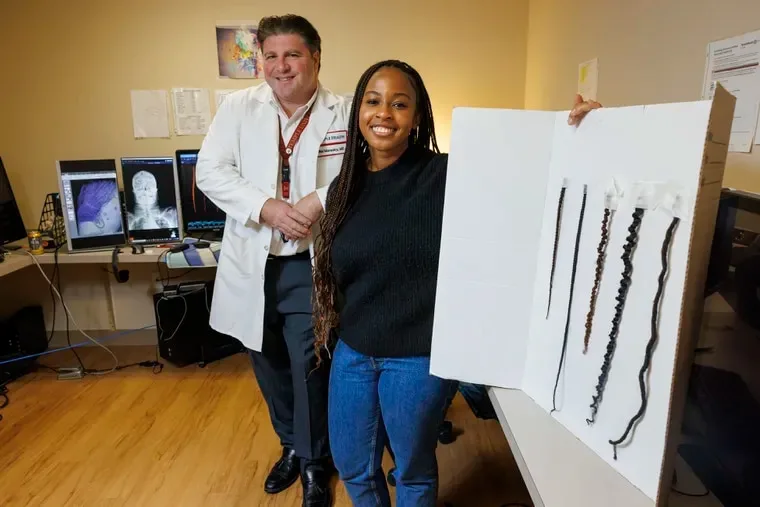
Temple University medical student Angela Udongwo spent her summer break quizzing Philadelphia-area physicians on their ability to identify the twists, locs and braids of Black patients’ hair when reading X-rays and other scans.
Her research found that many did not know what to look for, which could result in lower quality care for Black patients.
Whenever something obscures the image from a scan, physicians call it an artifact. The artifacts from common Black hairstyles appear as opaque squiggles, and can be mistaken for signs of disease. The medical literature on how to interpret these artifacts is sparse, leaving physicians room to make errors. This may lead them to direct patients to get more tests, a potentially costly inconvenience that can also expose them to unnecessary radiation.
Udongwo and her research mentor, Temple radiologist Hillel Maresky, are on a mission to educate physicians to distinguish artifacts from illness so Black patients get better care.
“The quicker that we do admit what we don’t know, we can have these conversations and be better doctors,” she said.
» READ MORE: How a Black patient’s textured hair nearly kept her from a needed medical procedure
Braids, twists, and locs
Udongwo joined Maresky’s lab for her summer research project between her second and third year of medical school. Once there, the Florida native and the daughter of Nigerian immigrants learned that Maresky was interested in studying Black hair.
Maresky trained in radiology in hospitals that served predominantly white patients. When he arrived at Temple in 2019, he was surprised by how little medical research existed to help him learn to identify locs, braids, and twists in radiological imagining. He wanted to create that knowledge base.
Udongwo volunteered to take the lead on the hair research project. She saw an opportunity to help address a health disparity, and advance her research skills.
Her first task was to educate her peers. The most common hairstyles for Black women were obvious to her, and so was the vocabulary around them, but it was all new to Maresky.
“These hairstyles are so common: braids, twists, locs,” Udongwo said. “They are tried and true.”
Udongwo taught her collaborators how to talk about Black hair. For example, there is nothing “dreadful” in locs, so no reason to call them dreadlocks.
These common Black hairstyles vary based on region, culture, and preference, according to Udongwo, who on a recent September morning had her hair styled with small to medium braids, which can take up to 10 hours to style.
The oils and conditioners used to maintain braids for weeks can create spots or squiggles in radiological images, even when the hair isn’t in the area that is being examined.
Aware that this can be an issue, some radiology practices ask patients to avoid these products. Maresky thinks that wrongly puts the onus on patients, whereas teaching physicians how to recognize Black hairstyles in radiological images deepens providers’ knowledge of their field.
“I think we can do better,” Maresky said.
» READ MORE: For years, Black people have waited longer for kidney transplants because of their race. A new rule aims to fix that.
Chutzpah
Udongwo began by reviewing all the medical research on the topic that she could find before designing her survey. She found almost no studies on the issue of Black hair in X-ray, CAT scans, and MRIs.
“It’s such a deafening silence,” she said.
The team decided to focus the research on determining how often radiologists read scans wrong because of these common Black hairstyles.
More than 70% of practicing radiology physicians are men and almost as many are white, according to a 2021 survey of the American Medical Association. Only 3% of radiologists are Black.
It’s not easy as a medical student, let alone a Black woman considering going into radiology, to walk into physician offices and challenge their knowledge. But that’s exactly what Udongwo did for the study.
“Angela came with the passion, with the understanding — and with the chutzpah,” Maresky said, referring to his mentee proudly using the Yiddish word for audacity.
Udongwo showed physicians a series of radiological images and asked them whether what they were seeing was an indication of disease or an artifact in hairstyles common in the Black community. The survey also asked physicians to rank how confident they are with their choice.
The preliminary analysis suggests that errors were common. The researchers also found that the longer radiologists had worked with diverse patient populations, the more confident they were when reviewing images.
The full results are under review ahead of publication in a medical journal.
Educating the masses
The Temple researchers plan to use their findings to create educational materials to teach radiologists about braids, locs and twists, and how their presence can affect their imaging reviews.
Udongwo has presented the early findings of their research at a conference of the Pennsylvania Radiology Society. The radiologists in attendance wanted to learn more.
“I’m surrounded by people who really like to learn and want to become better physicians,” she said. “I’m really excited to see where this goes.”
Maresky wants to share this information with his mostly white peers. He thinks Temple can lead the way on developing best practices for interpreting images of patients with these hairstyles.
“We may not be the most well endowed hospital in terms of donations and grants,” he said. “But we do have something that, I think, is even more powerful: A diverse patient population.”


